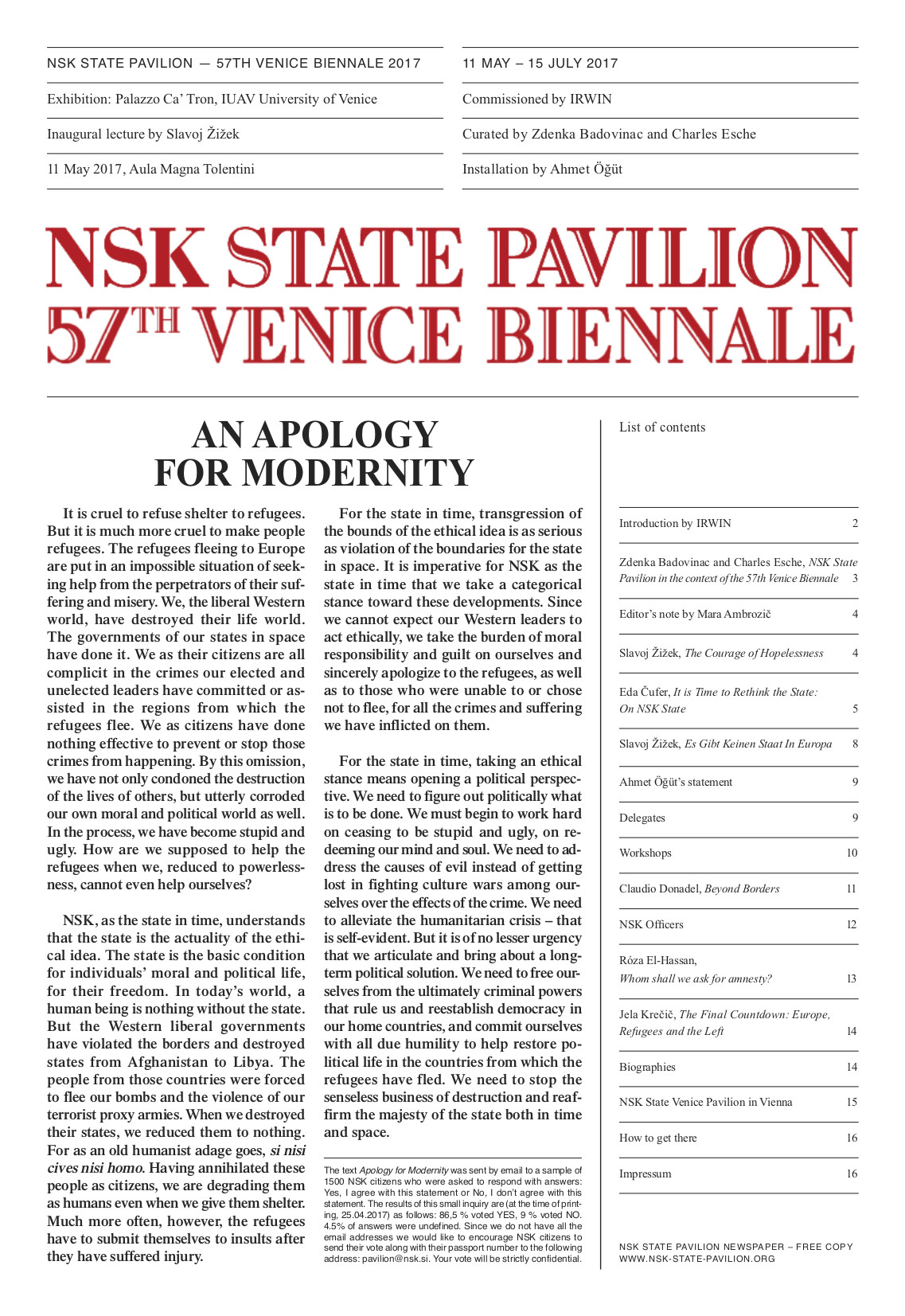NSK State Pavilion: 57th Venice Biennale (2017)
Filed under newspaper | Tags: · art, borders, migration, refugees

“NSK State in Time was founded by artist collective Neue Slowenische Kunst (NSK) in 1992. It was conceived as a utopian formation, which would have no physical territory and would not be identified with any existing nation state. Along with organising temporary embassies and consulates in cities such as Moscow, Berlin, Florence, Sarajevo and New York, NSK State in Time began issuing passports in 1993. There are currently about 15,000 NSK Passport holders around the world, with well known citizens including including Marina Abramović, John Baldessari, Boris Groys, Hans Ulrich Obrist and Slavoj Žižek.
The NSK State Pavilion provided an added and new dimension to NSK State in Time, built upon a collaboration with migrant communities, humanitarian protection applicants, and stateless individuals who are looking for new citizenship. At the Venice Biennale, the project aimed to rethink what a contemporary state can be, offering an open form of citizenship which contrasts with that generated by spatially-defined states.”
With contributions by Zdenka Badovinovac and Charles Esche, Eda Čufer, Claudio Donadel, Róza El-Hassan, Jela Krečič, and Slavoj Žižek.
Edited by Mara Ambrožič
Publisher Irwin, 2017
16 pages
Christian Ulrik Andersen, Geoff Cox, Jacob Lund (eds.): Nyhedsavisen: Public Interfaces, No. 1 (2011)
Filed under newspaper | Tags: · architecture, art, city, interface, public space, software, urbanism

Nyhedsavisen: Public Interfaces is a fake newspaper presenting cutting edge research in an accessible free tabloid format. The newspaper is a 100% genuine copy of the famous Danish newspaper Jyllands-Posten.
The increasing demand for publication of academic peer-reviewed journal articles must be met. Unfortunate examples demonstrate that this may lead to plagiarism. This is not a viable solution. Research must be original and academia is not lacking original content. But perhaps researchers need new visions of how to produce research? Perhaps the readers need new ways of consuming research? Why not imagine academic research as something that can be consumed on a daily basis, in the train or at the breakfast table?
On April 1, at 1 pm, Nyhedsavisen: Public Interfaces was handed out to the public at the metro station ‘DR Byen/Universitetet’ in Copenhagen as well as at the central railway station in Aarhus and the State Library. Also, issues were tactically placed in selected free newspaper stands and at University lunchrooms worldwide.
Emerging from the Digital Aesthetics Research Center and the Center for Digital Urban Living (Aarhus University), the aim of Nyhedsavisen: Public Interfaces is to encompass the changing concept of the ’public’. This is the result of an ongoing research in the computer interface.
The starting point for the newspaper is that the computer interface is a cultural paradigm affecting not only our creative production and presentation of the world but also our perception of the world. Its authors recognize that in the past decade, interfaces have been expanding from the graphical user interface of the computer to meet the needs of different new technologies, uses, cultures and contexts: they are more mobile, networked, ubiquitous, and embedded in the environment and architecture, part of regeneration agendas and new aesthetic and cultural practices, etc. Nyhedsavisen: Public Interfaces investigates these new interfaces that affect relations between public and private realms, and generate new forms urban spaces and activities, new forms of exchange and new forms of creative production.
The newspaper is organised into thematic strands (urban, art, capital) and brings together researchers from diverse fields – across aesthetics, cultural theory, architecture, digital design and urban studies – united by the need to understand public interfaces and the paradigmatic changes they pose to these fields.
All articles derive from an initial conference and PhD workshop held in January 2011, at Aarhus University.
Publisher Digital Aesthetics Research Center & Center for Digital Urban Living, Aarhus University, Aarhus, March 2011
ISBN 87-91810-18-3
Creative Commons Attribution-NonCommercial-ShareAlike License
24 pages
PDF
View online (HTML articles)
Continental Drift Zagreb (2008)
Filed under newspaper | Tags: · activism, art, autonomy, capitalism, cartography, creative industries, economy, geopolitics, neoliberalism, politics, power, war

“It’s always useful to turn dreams into realities, because you get to measure the differences and even let yourselves be guided by the intrinsic gaps between the two. Continental Drift was the dream of a geopolitical analysis carried out by a diverse group (theorists, artists, activists) and mapped onto everyday social and political life as an expanding set of explanations and expressive potentials. The dream was made in USA, and even on Wall Street in New York City, but it was realized by a group of immigrants, returning exiles and general misfits, all marked by the basic heresy of left positions in an age of liberal capitalist empire. By transplanting this inquiry to Zagreb, Croatia – the home of the What, How & For Whom? collective – it seems we are bringing a new dream into focus. The desire is that of widening the intrepretative circle, crossing divides of language and historical experience, trying to build capacities of understanding and confrontation between the immigrants, exiles and misfits of the big continental blocs and especially their edges – the cracks that open up wherever anyone can no longer stand what is taken and imposed as the norm. Empire as we see it is always falling apart, for better and usually for worse, under the pressure of massive processes which we are unlikely to even see coming, let alone grasp or have the agency to change in any way. Yet as the urgency and also the absurdity of the present predicament begins to rise in intensity, at least all around there are people trying similar experiments.” (Brian Holmes)
Novine Galerije Nova, No 15, May 2008
Publishers: What, How and for Whom/WHW, Zagreb; AGM, Zagreb
Editors: Continental Drift Zagreb team (Ayreen Anastas, Rene Gabri, Brian Holmes, Claire Pentecost, What, How and for Whom/WHW, Ivet Ćurlin, Ana Dević, Nataša Ilić, Sabina Sabolović)
Design: Dejan Kršić
36 pages

